I Can't Focus Without Blocking more than 100 sites
I can't focus on my work until I block more than 100 sites. It's a start, but it's still difficult. This is how I do it.
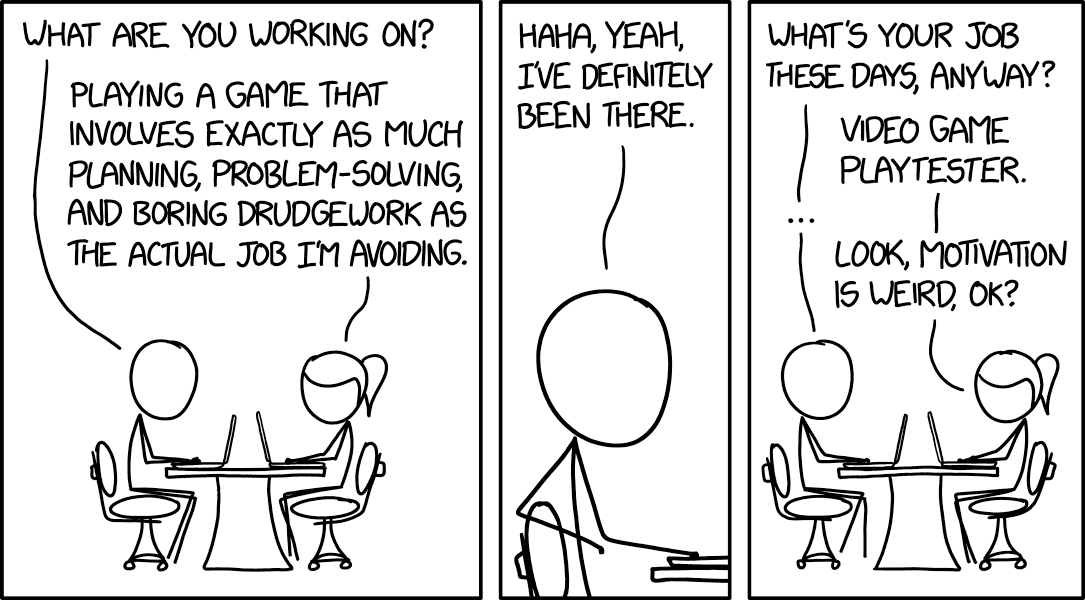
Focus & I have had a difficult relationship for as long as I can remember. Whether it's the wonderful world of the web, an ever-growing list of movies to watch, books to read, games to play, and podcasts to listen to, or the typical stray thought, my focus has always been easy to break. As you can imagine, this has been pretty detrimental. It's resulted in a lot of procrastination and a lot of guilt about not being productive.
Some measures were easy to take. One, keep the bedroom and office area separated. Though I keep books in the office, I'm less likely to reach for them than I am for the remote to play some background TV. Another measure I took was using an app, Focused Work, that could help me zero in on what I needed to be doing at a certain point. Still, the biggest issue remained: dealing with the web. This was the hardest – I'm in my 20s, so I hardly remember a life when the web wasn't a daily thing
It's far too easy to get distracted when you have all the world's entertainment & information at your fingertips, often for free, almost always with links to more. I have some favorite vices: Reddit, Hacker News, news sites, political sites, videos, RSS feeds, and comics. Like everyone, I tried to stay focused and distraction-free through sheer will; like many, I failed. Drastic measures were required.
That measure came in the form of Focus (no affiliation), a macOS app that lets you block websites & apps from opening for specific periods of time. When you try to open a blocked app, Focus automatically closes it. When you try to access a blocked website, Focus automatically redirects you to a random quote reminding you to get back to work (you can add more yourself). It works in all browsers in private browsing modes.
I bought it when it was $19.99, though it seems to be on a subscription model now with an expensive lifetime purchase. I'll list some more contenders later on, but I've no knowledge of them (except StayFocused, a Chrome extension which is free and which I used before buying Focus). I highly recommend checking out the free trial and then deciding whether or not it suits you.
Using Focus
Using Focus is ridiculously easy. The preferences window has 8 sections. 2 of them on the far-right are License & About – nothing germane to you here. The most important tabs are Blocking and Schedule.
Blocking
In the Blocking tab, you decide what you want to block. When you install the app, the usual suspects are there: some news sites, YouTube, Netflix, FaceBook, Twitter, etc.
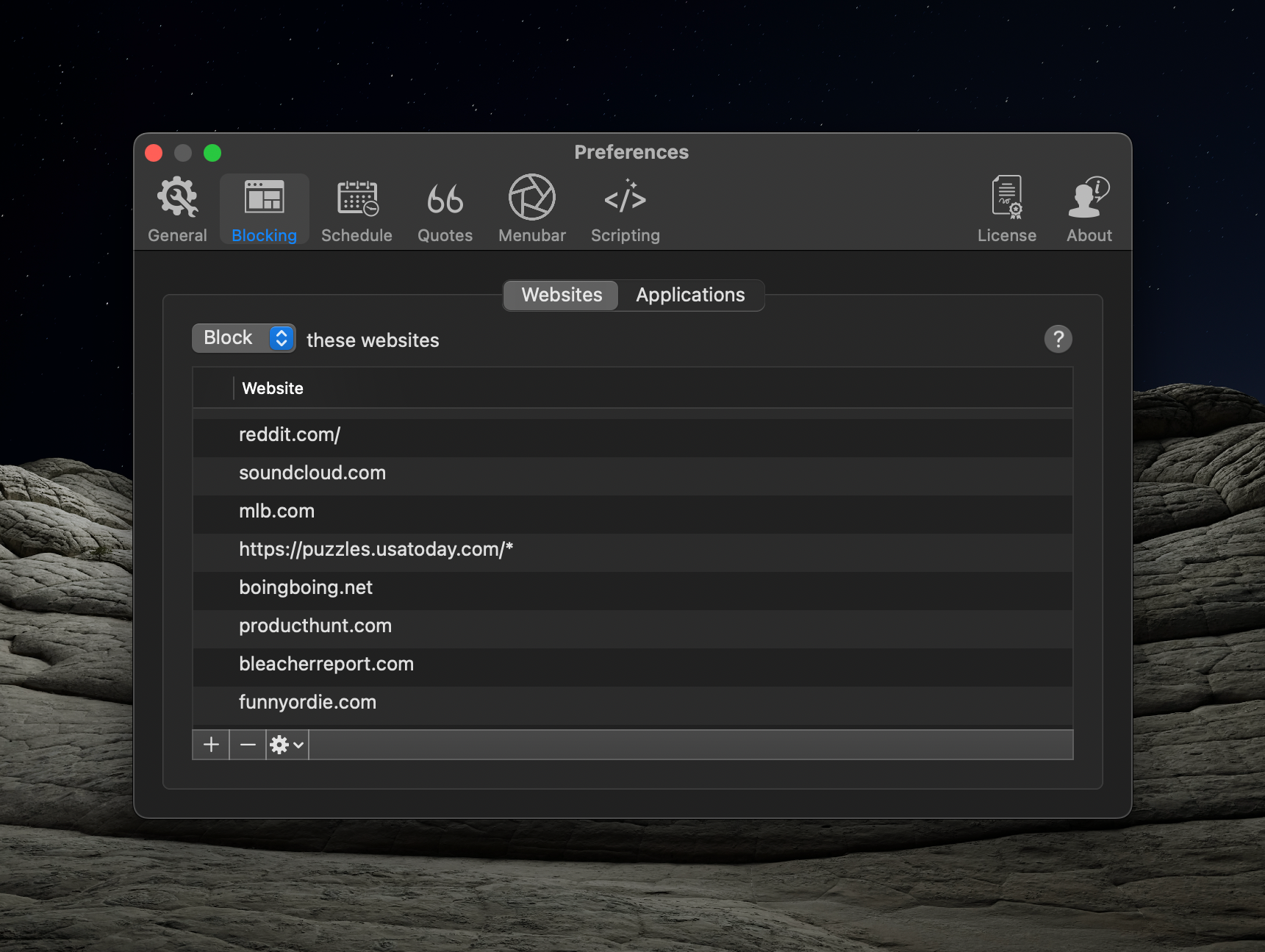
Blocking has two sections: Websites & Applications. Add distracting macOS apps in the Applications sections – Reeder 5 (my RSS reader of choice), YACReader (my comic book reader of choice), IINA (my media player of choice), etc. If you try to open them while Focus is active, they will automatically be closed. You can drag & drop the app into Focus, or use the + button.
Websites are more important because your most used app is probably your browser. You probably can't block your entire browser (though if you can, go for it) so you need to get specific about which sites distract you the most. You can add or subtract from the list as you need. I make great use of the wildcard character * (asterisk). The wildcard is used so you don't need to enter every possible URL that begins with similar characters.
Let's take cnn.com as an example. I can block just cnn.com if that's what I really want. But doing that won't block CNN's subdomains – us.cnn.com, edition.cnn.com. Even blocking just cnn.com might not stop me from opening or accessing a link like https://www.cnn.com/2022/09/01/health/ultraprocessed-foods-cancer-early-death-wellness/index.html. So what to do? Use the wildcard character. By blocking *cnn.com*, it'll block any URL that has the characters cnn.com in that exact order. You could take this a step further and block a keyword i.e. *youtube*. If youtube (not case-sensitive) appears anywhere in the URL, that page will be blocked. Focus allows for more complex Regex blocking, though I've preferred to keep it simple.
Just above the list, you'll see a dropdown that lets you toggle between "Block" and "Allow". Block is the default and makes Focus act as a blacklist. If you toggle it to Allow, Focus will act as a whitelist instead. That means everything will be blocked except the websites & apps you allow. This is a more dangerous setting so I keep it on Block and use the list as a blacklist.
Schedule
Focus allows you to set up schedules for when it's active. When it's active, it will block all the sites & apps you've told it to. If you hit + Add schedule, you can add a new day (Monday – Friday, Weekdays, Weekends) and an associated time. The time range is how long the Focus app will be active. You could do Weekdays 9AM to 5PM to make it so Focus will be active Monday through Friday from 9AM – 5PM. If you want Focus to be active for a 24-hour period, you choose the day and set the time to 12AM to 12AM i.e. Weekdays 12AM to 12AM, which will keep Focus active from 12AM Monday until, essentially, 11:59PM Friday (it'll automatically turn off 12AM Saturday).
Depending on your workflow, you can break apart the sessions as you'd like.
- Monday 9AM to 12PM
- Monday 1PM to 4PM
- Monday 5PM to 8PM
- Tuesday 8AM to 10AM
- Tuesday 12PM to 6PM
This way, you can give yourself predefined breaks where you can roam the web as you'd like. As soon as the clock crosses the threshold of a Focus session, Focus will reactivate and block any websites on your block list that you might be on.
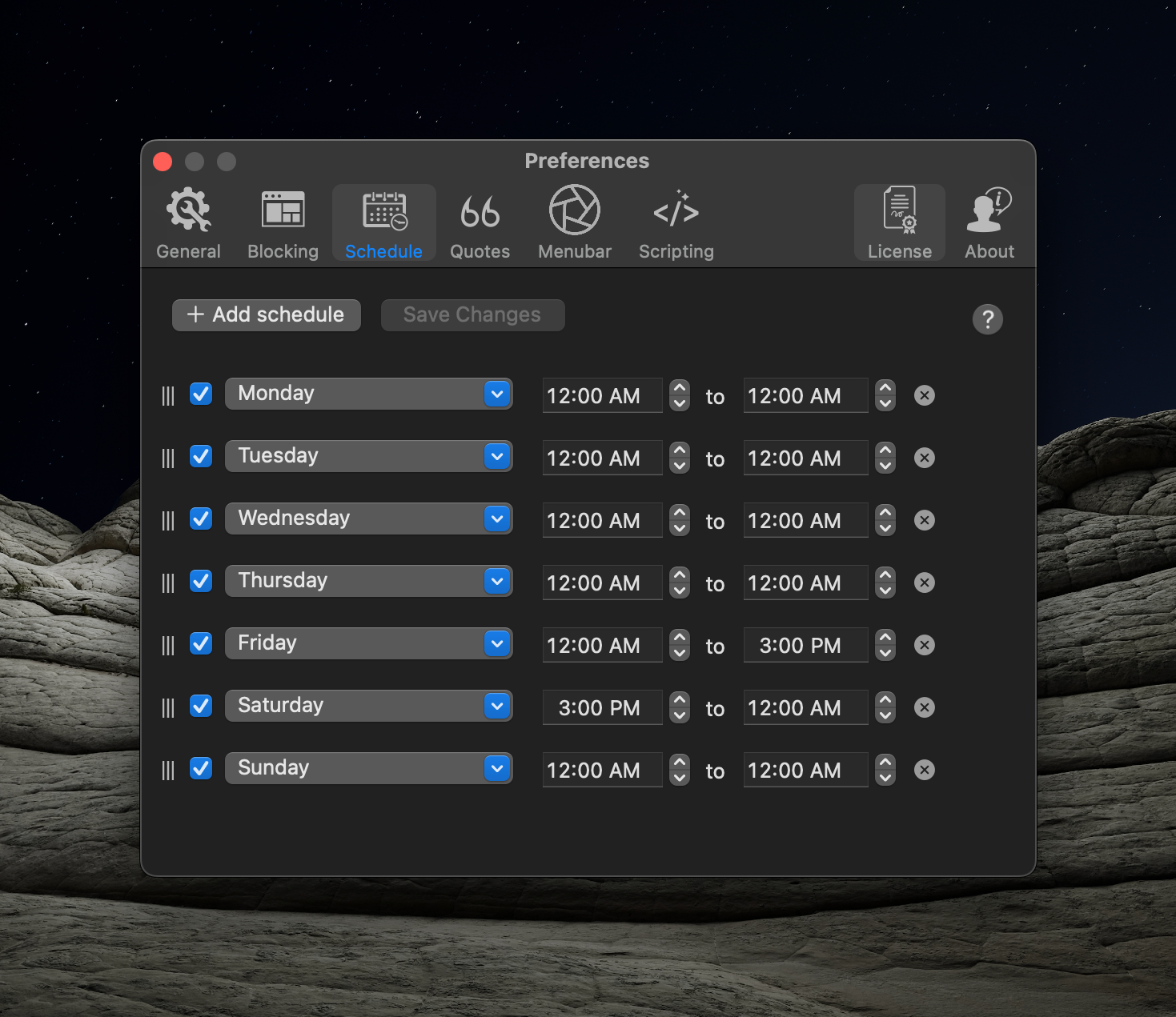
Other Sections to Note
There are a few other settings worth noting.
In the General tab, you can enable Hardcore mode. Hardcore mode locks preferences during Focus sessions, meaning you cannot deactivate Focus or make any changes to it during a Focus session. I keep Hardcore mode on. If I leave it off, I'll be tempted to deactivate a Focus session for the slightest reason. Temptation is strong and I need to head it off as much as I can.
You can also set up breaks within the Focus sessions. For example, you can give yourself a 10-minute break every hour, a 60-minute break every four hours, or a 22-minute break every 3 hours. Whatever you want. A break can automatically expire if you let the timer lapse, or you can turn it off yourself.
I don't use Pomodoro mode or Password mode. Pomodoro mode loops between timers and breaks. This means that a Focus session will run for a specific amount of time (say 25 minutes) and then deactivate for a specific amount of time for a break (say 5 minutes) and will keep alternating between that until the Focus session set in the schedule ends. This abides by the Pomodoro technique, which a lot of people find useful. I use the Pomodoro technique myself, but I use the Focused Work app.
Password mode just locks preferences. If you know the password, that's not much help. It's only useful if someone else enables it and only they know the password.
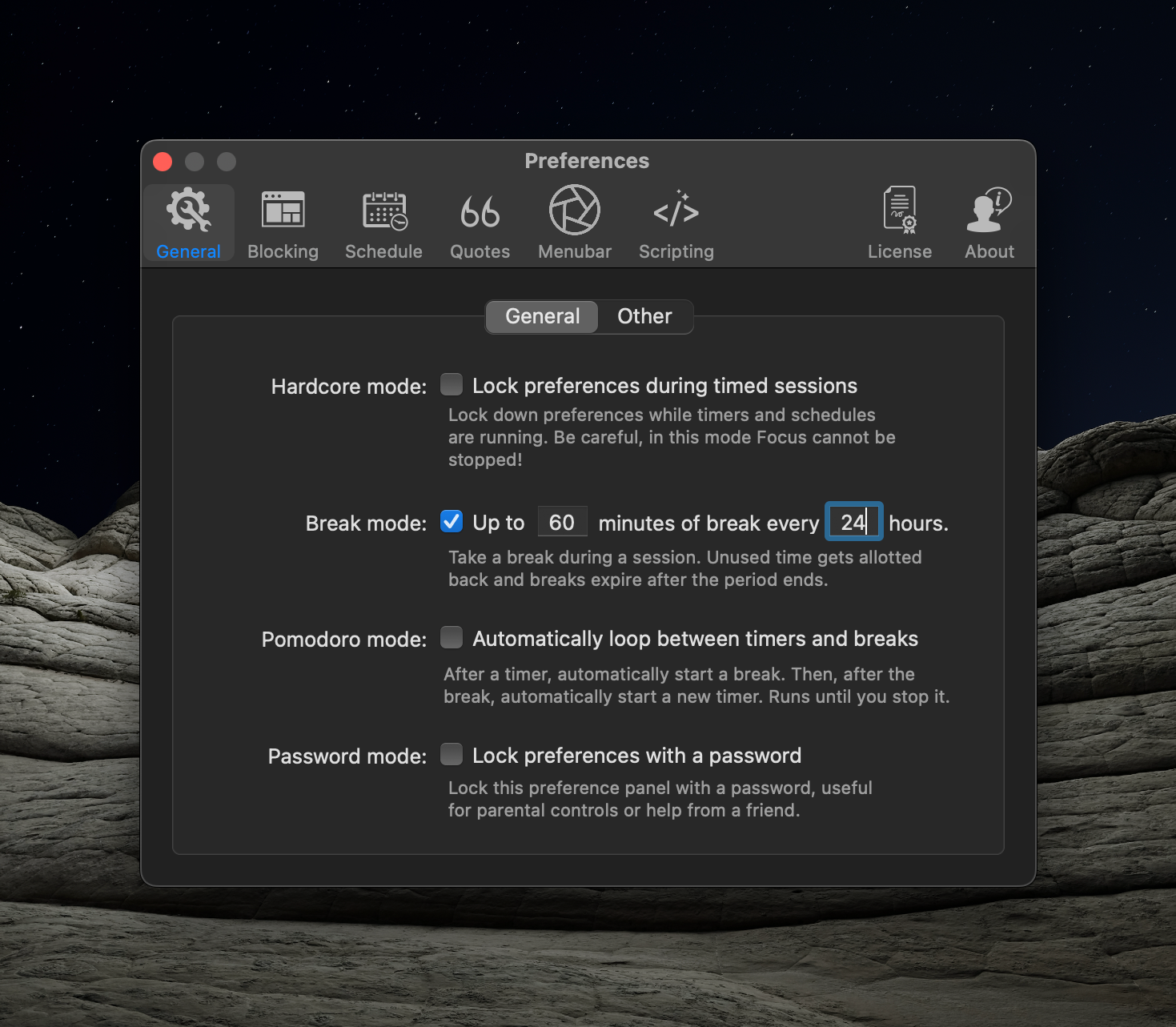
The Quotes tab has a list of quotes & their authors that Focus displays when you visit a blocked site during an active Focus session. Feel free to add some that have significance for you.
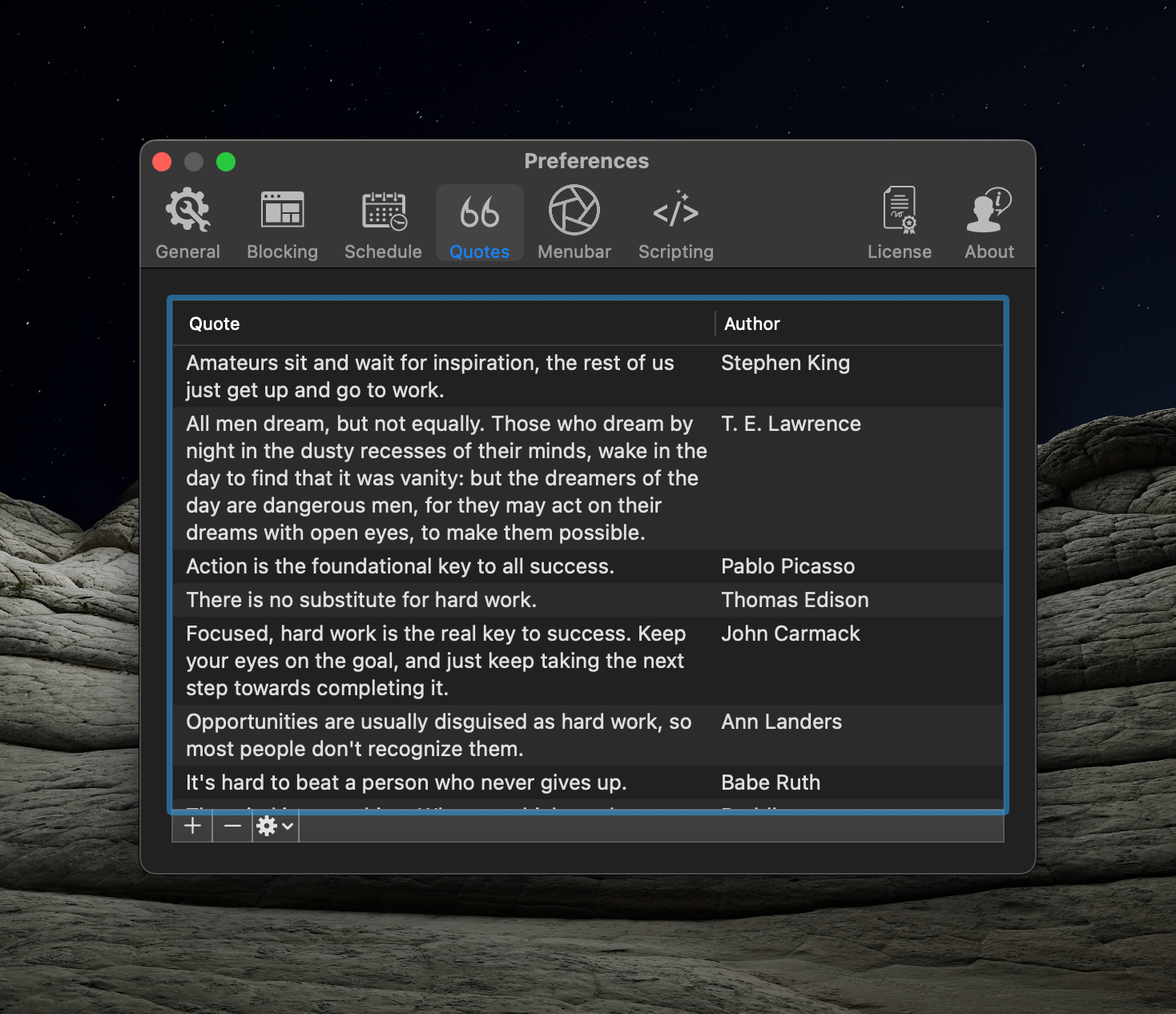
Focus has some scripting options, though I haven't had a need to use them.
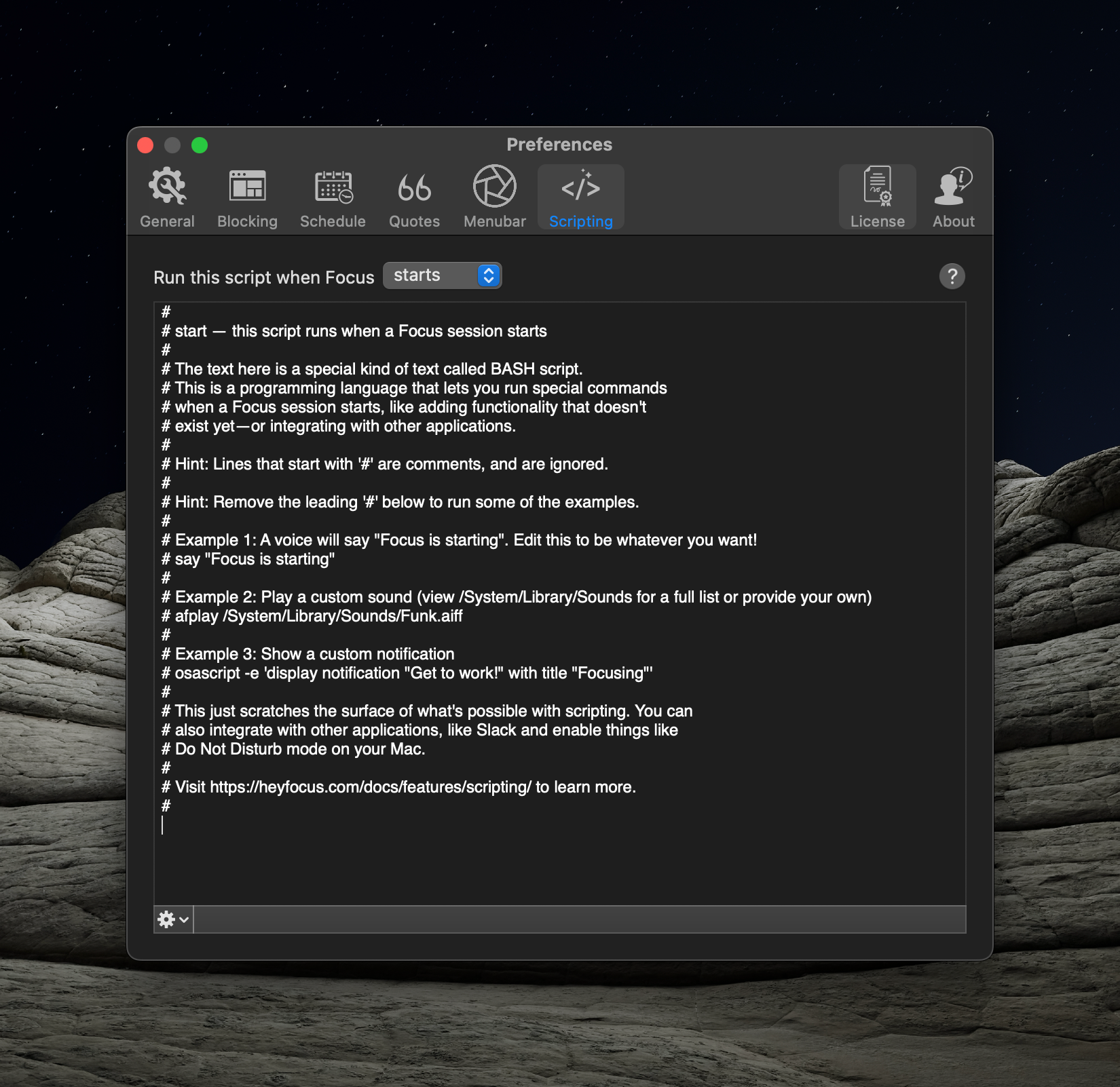
Suggestions
I suggest playing around with Focus and leaving Hardcore mode off until you've arrived at a happy medium. Play around with the sites you want to add, and how specific you want to be with them. Maybe you really like comics and you just need to block anything with the word comic in it i.e. *comic*. Or maybe there're just a few sites that draw your attention i.e. daringfireball.net, macstories.net, nytimes.com, wsj.com, etc.
Adjust the schedule to your liking until you find something that works. This is meant to be a journey, not a one-size-for-all-times solution. What works for you in Focus right now might not be what you need a month, six months, or a year from now. By then, you might not even need Focus. James Clear mentions that it takes time to build a habit – perhaps, after using Focus for a few months, you might not even need it anymore.
On average, it takes more than 2 months before a new behavior becomes automatic — 66 days to be exact. And how long it takes a new habit to form can vary widely depending on the behavior, the person, and the circumstances. In Lally's study1, it took anywhere from 18 days to 254 days for people to form a new habit.
This is a case of know thyself. You know what you need better than I do.
Other Options
I haven't had reason to try other options because I found one that worked. If you find something that meets your needs, stop searching for something better (this is a do as I say, not as I do bit of advice – I violate it in other ways all the time, though I shouldn't. Focus is a surprising exception). I had tried Stay Focused, a free Chrome extension, for a while (several years ago) but gave up on it after I kept finding ways around it. I also wasn't comfortable with the amount of access I had to grant it.
Some more options include:
- BlockSite
- Freedom
- Cold Turkey – It has an interesting Pause for a Cause feature that lets you make a donation to the World Wildlife Fund for a 10-minute break, but it's easy to get around.
- You can block sites at the DNS level, but I don't recommend this unless you really know what you're doing. I've not tried this, nor do I think I will.
Focus Is a (Long) Journey, Not a Light Switch
Blocking every site that could be a distraction was a nuclear option, but one I had to take. I removed the Safari app on my iPhone and keep my iPad in a separate room, which creates a hurdle (that I still jump over more than I'd like to admit – reinstalling Safari is as simple as toggling a button, after all). I'll be the first to admit that I haven't found a perfect answer, and I'm not sure one exists. What I've done is create hurdles that future me will – hopefully – be too lazy to jump. I win against myself more than I used to, but the hits keep coming. Steven Pressfield talks about Resistance a lot in The War of Art – his concept of a universal force that tries to stop you from doing what you must in favor of doing what you wish. Resistance wants you to remain comfortable. Everyone will need to deal with that in their own way – for me, site-blocking was necessary. I did what I had to.
It's important to distinguish these as hurdles and not barriers. I feel the latter would imply something insurmountable or extremely difficult to get through. This isn't that. What I've done is set up inconveniences for myself. These aren't raging rivers that I need to row across; they're more like self-deployed puddles of mud that I need to evade so I don't mess up my shoes.
Finding Focus nirvana is going to take a long time and there'll be plenty of misses. I've been on this journey for years and I still screw up. But I think I'm getting close. For a lucky few, focus is a light switch to be turned on and off at will. That's how it was for Napoleon, who said “When I wish to interrupt one train of thought, I shut that drawer and open another. Do I wish to sleep? I simply close all the drawers, and there I am – asleep.” For mere mortals, it's a journey – a long one that'll end when the lights go out.
